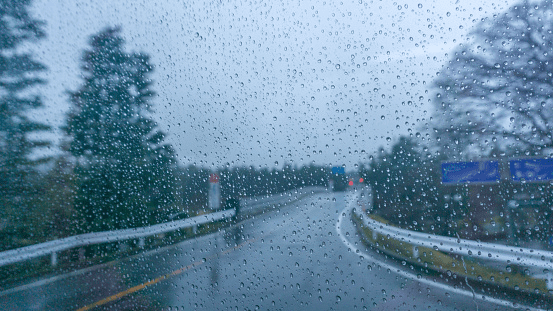Drizzle or downpour, drive safely in the rain

Beware of standing water in the roadway.
No matter what part of the country you live in, eventually everyone will encounter driving in the rain.
Whether it’s a light sprinkle or a full downpour, it’s important to be prepared.
Check mechanics
Make sure your auto is in good condition before bad weather hits. Check your headlights, taillights and windshield wipers to ensure they are in good working order. Adequate tire tread is also vital to maintaining your safety while navigating stormy weather. Balding tires have reduced traction on wet roads.
Turn on headlights
Turn on your headlights during a rainstorm during the day or night to improve your visibility. Also, even if you feel you can adequately see, it will improve your visibility to other drivers. Most US states now enforce “wipers on, lights on” laws. The National Highway Traffic Safety Administration has also approved regulations that will allow auto manufacturers to install adaptive headlights in cars, similar to existing laws in Europe and elsewhere.
Drive smarter
Slow down: Visibility may be poorer than usual when it rains and the pavement is slick; travel at a slower speed, and navigate turns with caution.
Keep your distance: While it’s always important to keep your distance from other drivers, it may take you longer to brake when the road is wet. You also do not know how much experience other drivers have in navigating stormy weather.
Give full attention: Keep focused with both hands on the wheel. Turn off cruise control so you are in full command of the auto and ready for action.
Be patient: Assume traffic will be moving at a slower pace.
Beware of hydroplaning
One thing to be extra mindful about when it’s raining is the possibility of hydroplaning. Hydroplaning occurs when the vehicle slides uncontrollably on a wet surface. This can happen when the tires encounter more water than the treads can displace. If this happens, ease off the accelerator and continue to drive steadily forward. Do not slam on the brakes, which could send your vehicle out of control.
Ventilate your car
Car windows often become foggy when it’s raining due to increased humidity inside the car. Use your ventilation system to equalize the temperature between the inside and outside of the car, reducing fog inside your windows. If you are no longer able to see out of your windows, pull over.
Watch out for standing water
Standing water in the road can hide dips, debris and washouts, and it’s easy to misjudge the water’s depth. Even on a familiar road, turn around and find another route to your destination. Just 6 inches of water is enough to flood most passenger autos, causing them to stall. You can quickly become stranded: a dangerous situation in rising waters. Standing water also can wreak havoc on your engine, electronics and your car’s interior.
Know your area
If you are driving in an unfamiliar location, take extra precautions. In locations that get infrequent rain, the roads tend to be extra slick with buildup of various car fluids that don’t get washed away regularly.
This loss control information is advisory only. The author assumes no responsibility for management or control of loss control activities. Not all exposures are identified in this article. Contact your local, independent agent for insurance coverage advice and loss control information.







